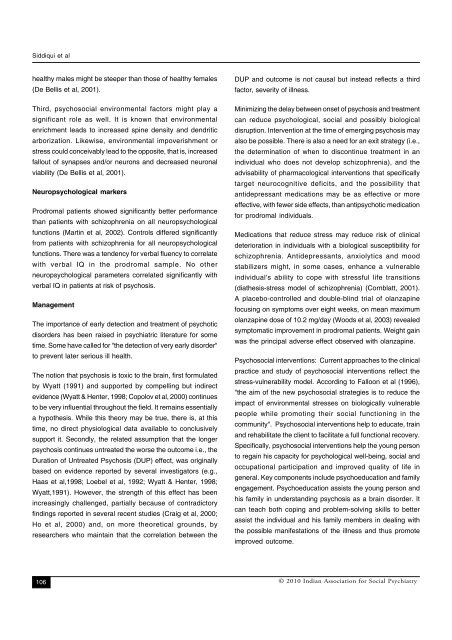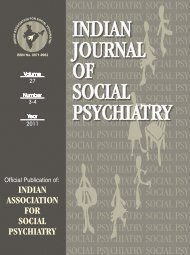IJSP-2010(3-4) - Indian Association For Social Psychiatry
IJSP-2010(3-4) - Indian Association For Social Psychiatry
IJSP-2010(3-4) - Indian Association For Social Psychiatry
Create successful ePaper yourself
Turn your PDF publications into a flip-book with our unique Google optimized e-Paper software.
Siddiqui et al<br />
healthy males might be steeper than those of healthy females<br />
(De Bellis et al, 2001).<br />
Third, psychosocial environmental factors might play a<br />
significant role as well. It is known that environmental<br />
enrichment leads to increased spine density and dendritic<br />
arborization. Likewise, environmental impoverishment or<br />
stress could conceivably lead to the opposite, that is, increased<br />
fallout of synapses and/or neurons and decreased neuronal<br />
viability (De Bellis et al, 2001).<br />
Neuropsychological markers<br />
Prodromal patients showed significantly better performance<br />
than patients with schizophrenia on all neuropsychological<br />
functions (Martin et al, 2002). Controls differed significantly<br />
from patients with schizophrenia for all neuropsychological<br />
functions. There was a tendency for verbal fluency to correlate<br />
with verbal IQ in the prodromal sample. No other<br />
neuropsychological parameters correlated significantly with<br />
verbal IQ in patients at risk of psychosis.<br />
Management<br />
The importance of early detection and treatment of psychotic<br />
disorders has been raised in psychiatric literature for some<br />
time. Some have called for "the detection of very early disorder"<br />
to prevent later serious ill health.<br />
The notion that psychosis is toxic to the brain, first formulated<br />
by Wyatt (1991) and supported by compelling but indirect<br />
evidence (Wyatt & Henter, 1998; Copolov et al, 2000) continues<br />
to be very influential throughout the field. It remains essentially<br />
a hypothesis. While this theory may be true, there is, at this<br />
time, no direct physiological data available to conclusively<br />
support it. Secondly, the related assumption that the longer<br />
psychosis continues untreated the worse the outcome i.e., the<br />
Duration of Untreated Psychosis (DUP) effect, was originally<br />
based on evidence reported by several investigators (e.g.,<br />
Haas et al,1998; Loebel et al, 1992; Wyatt & Henter, 1998;<br />
Wyatt,1991). However, the strength of this effect has been<br />
increasingly challenged, partially because of contradictory<br />
findings reported in several recent studies (Craig et al, 2000;<br />
Ho et al, 2000) and, on more theoretical grounds, by<br />
researchers who maintain that the correlation between the<br />
106<br />
DUP and outcome is not causal but instead reflects a third<br />
factor, severity of illness.<br />
Minimizing the delay between onset of psychosis and treatment<br />
can reduce psychological, social and possibly biological<br />
disruption. Intervention at the time of emerging psychosis may<br />
also be possible. There is also a need for an exit strategy (i.e.,<br />
the determination of when to discontinue treatment in an<br />
individual who does not develop schizophrenia), and the<br />
advisability of pharmacological interventions that specifically<br />
target neurocognitive deficits, and the possibility that<br />
antidepressant medications may be as effective or more<br />
effective, with fewer side effects, than antipsychotic medication<br />
for prodromal individuals.<br />
Medications that reduce stress may reduce risk of clinical<br />
deterioration in individuals with a biological susceptibility for<br />
schizophrenia. Antidepressants, anxiolytics and mood<br />
stabilizers might, in some cases, enhance a vulnerable<br />
individual's ability to cope with stressful life transitions<br />
(diathesis-stress model of schizophrenia) (Cornblatt, 2001).<br />
A placebo-controlled and double-blind trial of olanzapine<br />
focusing on symptoms over eight weeks, on mean maximum<br />
olanzapine dose of 10.2 mg/day (Woods et al, 2003) revealed<br />
symptomatic improvement in prodromal patients. Weight gain<br />
was the principal adverse effect observed with olanzapine.<br />
Psychosocial interventions: Current approaches to the clinical<br />
practice and study of psychosocial interventions reflect the<br />
stress-vulnerability model. According to Falloon et al (1996),<br />
"the aim of the new psychosocial strategies is to reduce the<br />
impact of environmental stresses on biologically vulnerable<br />
people while promoting their social functioning in the<br />
community". Psychosocial interventions help to educate, train<br />
and rehabilitate the client to facilitate a full functional recovery.<br />
Specifically, psychosocial interventions help the young person<br />
to regain his capacity for psychological well-being, social and<br />
occupational participation and improved quality of life in<br />
general. Key components include psychoeducation and family<br />
engagement. Psychoeducation assists the young person and<br />
his family in understanding psychosis as a brain disorder. It<br />
can teach both coping and problem-solving skills to better<br />
assist the individual and his family members in dealing with<br />
the possible manifestations of the illness and thus promote<br />
improved outcome.<br />
© <strong>2010</strong> <strong>Indian</strong> <strong>Association</strong> for <strong>Social</strong> <strong>Psychiatry</strong>



